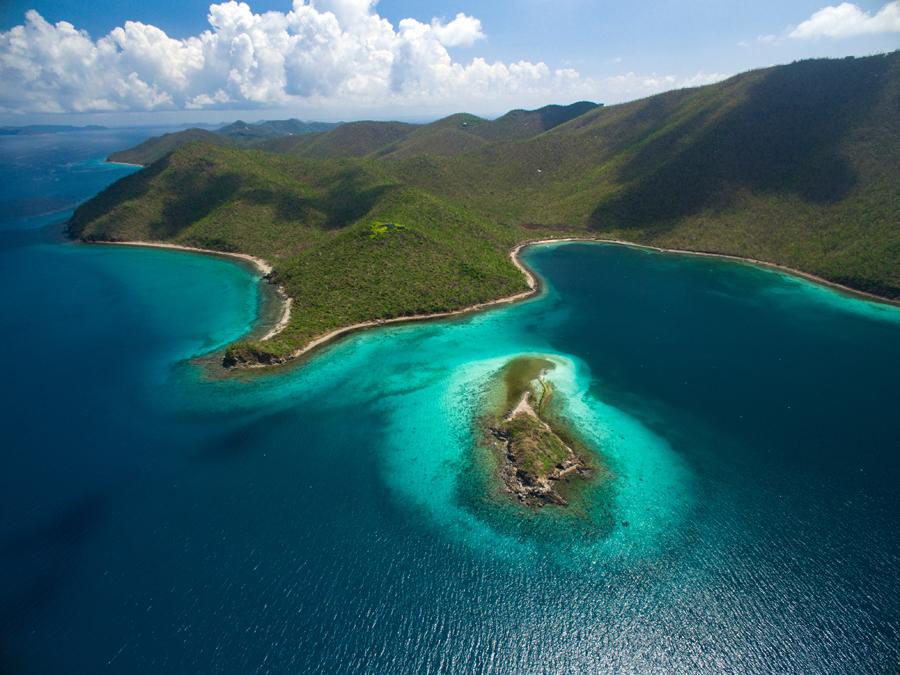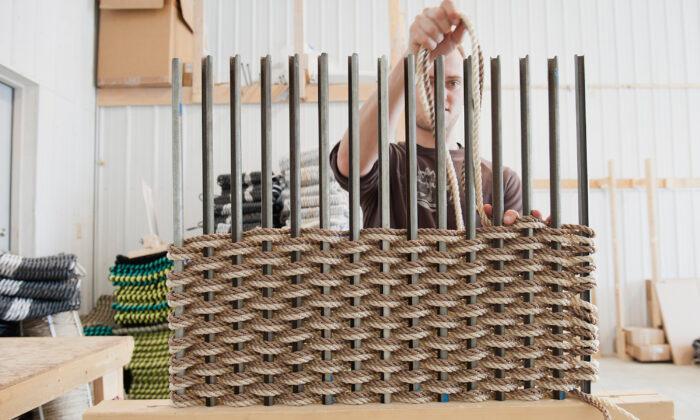Picture this: You’re perched under a beach umbrella watching gentle waves lap the shore, a sea of crystal-clear water stretching before you toward an orange-gold setting sun. Your skin is bronzed from a day’s worth of Vitamin D; your hair is happily crusted in salt; you’re taking lazy sips of rum punch with a smile, lost in a tropical-island reverie.

Waterlemon Cay. Courtesy of U.S. Virgin Islands Department of Tourism
Seems like a memory of vacations past—and even the ability to vacation seems like a long-gone relic of the good ol’ days, doesn’t it? Not so fast. I’m describing a scene from a trip I recently took—our first time on a plane in three months—and best of all, a trip that gave a whole new meaning to “domestic travel.”

A nearly empty terminal at Miami International Airport on June 4. Skye Sherman
The U.S. Virgin Islands began welcoming tourists back on June 1, among the first of the Caribbean islands to do so. They’re an American territory, so despite the far-away feel, you’re still on U.S. soil: you don’t even need a passport to visit. As more destinations line up to follow suit and reopen over the next few months, here’s a glimpse of what you can expect.

Views along Highway 60 on the way to Point Udall. Skye Sherman
What’s It Like to Travel Right Now?
It’s definitely different. At Miami International Airport, for example, a typically buzzing transit hub, our departure terminal felt deserted: all stores in sight were closed except for Einstein Bagels, and there were very few other passengers. About 95 percent of people were wearing masks, based on my estimations, though the airport doesn’t require them. The security line was empty, so TSA PreCheck took even less time than usual, but in general, airport procedures seemed the same.All airlines have different protocols in place, but on our American Airlines flight, every single seat was full, which was uncomfortable (even more than usual). However, they’ve implemented some safety measures: every passenger is required to wear a proper facial covering, and cart service isn’t running. Instead, a flight attendant delivers a paper bag containing water, a snack, and a single-use packet of hand sanitizer.

Temperature check upon landing at the airport in St. Croix. Skye Sherman
As we deplaned at Henry E. Rohlsen Airport in St. Croix, we were immediately met with a line of National Guard soldiers, who took our temperatures using infrared thermometers. Upon confirming the absence of a fever, we were permitted to progress to the next stage, which was sending our bags through a van to sanitize them. We picked our bags up on the other side of the van and were on our way.
Other than the new protocols, traveling felt the same as always—exhilarating, slightly nerve-wracking, and altogether thrilling.
Of course, every destination has different protocols in place; some places require a mandatory quarantine for 14 days or the duration of your trip, whichever is shorter, and some airports have rapid COVID-19 testing for every arrival, if they’re permitting any entry at all. This was not the case in St. Croix, but do your research before booking a trip anywhere.
Since the situation is different at every airport and in every country, it’s also probably best to stick to direct flights for now to avoid any potential complications.

The luggage goes through some sort of sanitization van at the St Croix airport. Skye Sherman
Is It Safe to Visit the US Virgin Islands?
Your safety depends, in large part, on what measures you’re willing to take to protect yourself and others, but the USVIs were not a virus “hotspot.” The Virgin Islands Department of Health reports that the islands have seen 73 cases total, with 64 recovered, 6 deaths, and 3 active.As far as a safe “first trip” post-lockdown, I found the USVIs to be an approachable, comfortable option for satiating wanderlust. During their current phase of reopening, there’s an island-wide policy of “No mask = no service,” and at our hotel, for example, a proper facial covering was required at all times, except while swimming in the pool or ocean or sitting down to eat. Social distancing measures are also in effect.
Remember, too, that a trip to the USVIs falls under the domestic umbrella, so there’s little risk of issues with re-entry upon your return. “Welcome home” is the standard greeting for Americans in the USVIs, which immediately endeared us to these islands with a sense of pride.

A little free library found on the streets of Frederiksted behind Polly's at the Pier, a popular restaurant. Skye Sherman
Were There Any Other Tourists?
We headed to St. Croix on June 4—just three days after its June 1 reopening—and stayed in the less touristy Frederiksted on the west side of the island, as opposed to the more developed Christiansted. We encountered only a few other tourists, including a family from Missouri who are St. Croix regulars; they landed in St. Croix around noon on June 1, having boarded the very first flight back to the USVIs.Other than that, the only other visitors we met were a group of FEMA volunteers who were on-island to assist with a potential surge that never occurred. In fact, most people assumed we were locals because we were there.
Do You Have to Go Through Customs to Visit the USVIs?
You pass through customs on the way out (we went through customs inside STX airport) but do not need to show a passport, only your ID. Upon landing in Miami, we were in a typical domestic arrivals terminal and walked right out to our car—there were no other temperature screenings, health checks, or passing through customs.
Sunset view from Sand Castle on the Beach in Frederiksted. Skye Sherman

Sunset view from Sand Castle on the Beach in Frederiksted. Skye Sherman

Mahi bites at Beach Side Cafe, served with passion fruit aioli. Skye Sherman

Sunday brunch menu at Ci Bo Né, a restaurant in Frederiksted. Skye Sherman
What Was the Hotel Experience Like?
We stayed at a boutique beachfront hotel, Sand Castle on the Beach, and appreciated their stringent check-in procedure. Upon arrival, your luggage is sprayed with sanitizer and you’re subject to another temperature check and a brief health screening consisting of questions about whether you’ve been in contact with COVID-19 patients or have any symptoms. You’re provided a squirt of hand sanitizer and only one party is allowed at the check-in desk at a time.
A traditional Crucian breakfast at Ci Bo Né. Items typically found on a traditional Crucian breakfast plate include salted fish, a hard-boiled egg, chopped greens and cucumber salad, and some sort of bread, like a johnny cake or butter bread. Skye Sherman
Opting for a locally owned intimate property also supports the local economy and promises smaller crowds. Our stay included breakfast—for now, that’s grab-and-go pre-packaged items and Keurig coffee pods—as well as snorkel gear, personalized service, and a location directly atop the best stretch of beach in St. Croix.

Point Udall, the easternmost point of the United States. Courtesy of U.S. Virgin Islands Department of Tourism
What Is There to Do in the USVIs?
While some businesses remain closed (or open with limited hours), just like on the mainland, we were still able to enjoy a trip to St. Croix full of island-inspired activities—albeit with masks on.We rented a car from Judi of Croix and drove the entire perimeter of St. Croix, from our hotel in Frederiksted to Point Udall, the easternmost point of the United States; we located and swam in the famous Monk’s Bath, a pool carved out of rocky shoreline by monks in the 1600s; we enjoyed endless fresh fish and Cruzan Confusion cocktails, mostly at our hotel’s on-property beachfront restaurant, Beach Side Café; we took a kite surfing lesson from Leading Edge Kite School; we rented gear from Adventures in Diving STX and set out for a morning of scuba diving; we spent late nights at Lost Dog Pub, where local legend Dumplin’ was serving his famous Conch Water soup and an iconic stilt-walking Moko Jumbie showed up to mingle; we made the most of our tropical surrounds and swam, sunbathed, and generally enjoyed the almost-forgotten pleasure of leaving home.

Views from Point Udall, the easternmost point of the United States. Skye Sherman
Other popular things to do in St. Croix, which we didn’t have time for, include hiking through the inland rainforest, horseback riding on the beach with Cruzan Cowgirls, shopping for an original hook bracelet from Sonya, booking a Buck Island sailing tour with Big Beard’s Adventure Tours, and touring breweries and distilleries like the Cruzan Rum Distillery, Mutiny Island Vodka at Sion Farm Distillery (it’s vodka distilled from breadfruit!), and Leatherback Brewing Company.
As a U.S. territory, St. Croix felt both familiar and foreign; you’ll be taking in the colorful colonial architecture when a U.S. mail truck goes barreling past. Orange and red royal poinciana trees dot the island, and prices are comparable to the mainland—save for alcohol, which can seem mysteriously cheap for an island destination, with cocktails running just $8 to $12 island-wide.
Skye Sherman is a freelance travel writer based in West Palm Beach, Fla. She covers news, transit, and international destinations for a variety of outlets. You can follow her adventures on Instagram and Twitter @skyesherman





